

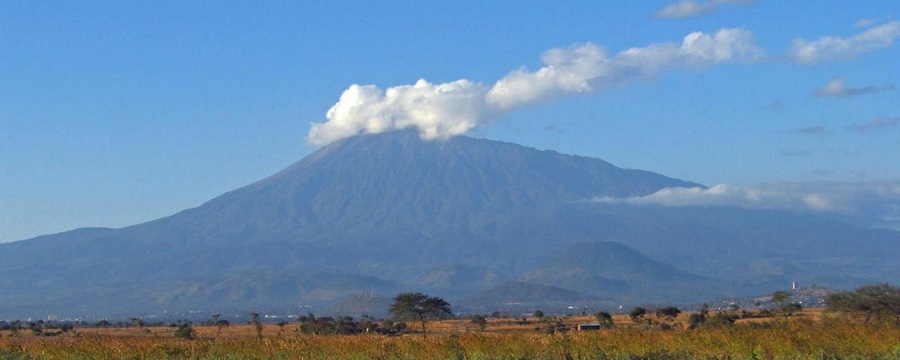
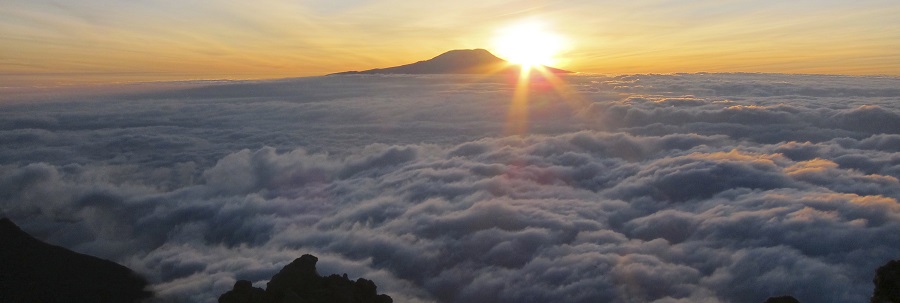
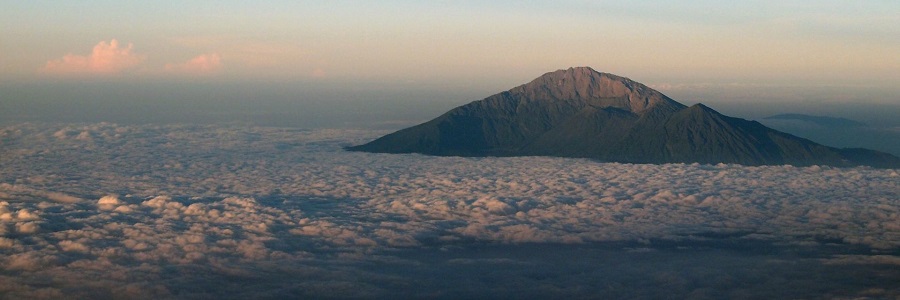

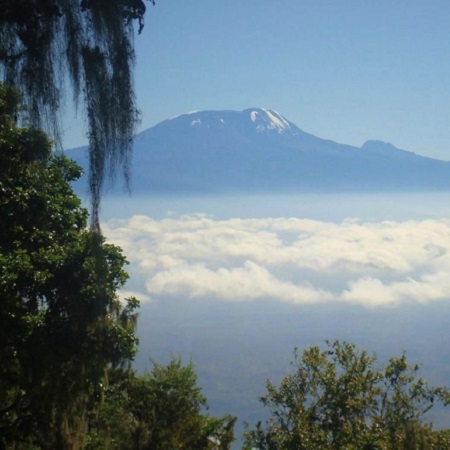
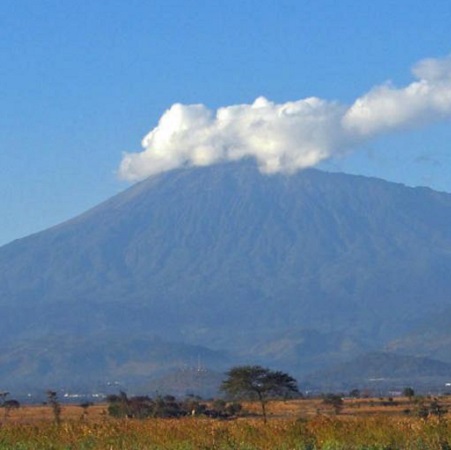
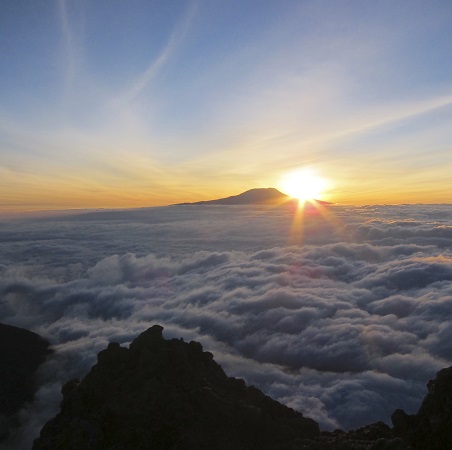
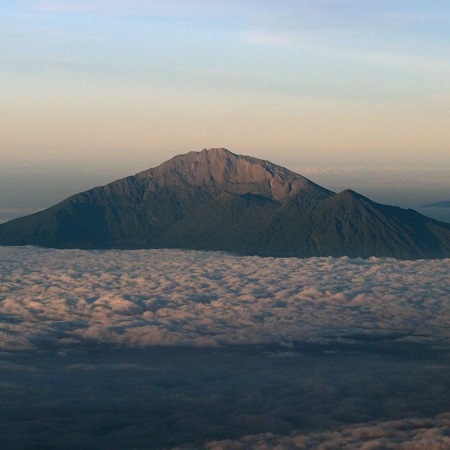
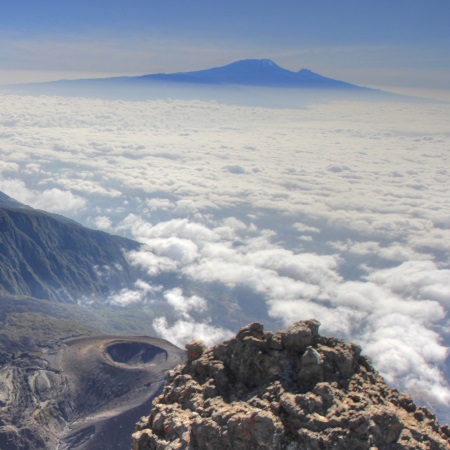
Meru is eengeweldigevoorbereidingswandelingvoor het beklimmen van de Kilimanjaro, of eenspectaculairetrektochtvoordegenen die nietverplichtzijn om de Kilimanjaro tedoen. Je wandeltlangswildedieren, het landschap is spectaculairen de zonsopgang op de top heeft de Kilimanjaro alsachtergrond. Hoewel het in slechts 4 dagenkanwordengedaan, is het geengemakkelijke top om de top tebereiken. Om de top (bijna 15.000 voet) tebereiken, wordt er in het donkeren op grotehoogte op rotsengeklauterd. Je moetvoorbereidzijnop ten minste 10 uurwandelen op de dagvan de top. Vooreengemakkelijkerewandelingkun je gewoonnaar Rhino Point klimmenvoorzonsopgang met uitzicht op de Kilimanjaro, en dan afdalen.
Mt. Meru ligt in Arusha National Park. In Arusha National Park moeten alle wandelaarswordenvergezeld door eengewapendeboswachter. Dezeboswachter is rechtstreeks in dienst van het nationale park. Je hebtook je eigen berggids, die de bemanningaanstuurten op je veiligheid let. De parkwachterheeft de autoriteit om beslissingentenemenzoalspadkeuzes, tempo, etc. Arusha National Park kangroepenmensencombineren om mee tewandelenéénparkwachter, daaromkunnen we geenvolledigprivé Meru-trektochtgaranderen.Arusha National Park vereist de huur van dragers die specifiekzijnvoor Arusha National Park, die wordentoegewezenzodra je aankomtbij de registratie van het parcours.
BeginnendbijMomela Gate, loopt het pad door open grasland met Kaapse buffelsenwrattenzwijnen. Met eenbeetjegelukzie je misschienookgiraffenenolifanten. Vervolgeengestageklim door bergbossen. U kuntuw lunch nuttigenbij de beroemde “vijgenboom”. Na de lunch gaat de tochtverder door minder dichtbos, waarveelvogelsenapenzijn, waaronder de zwart-witte colobus. Halverwege de middagheb je jeeersteuitzicht van dichtbij op de torenhogekliffenen de Ash Cone. Miriakampa Hut, gelegen in eenidyllische met gras begroeide open plek, wordt op tijdbereikt om tegenieten van de middagzoneneenprachtiguitzicht over de omliggendevlaktesrichting Kilimanjaro.
Maaltijden: LD
Budget accommodatie: Miriakampa Hut
De wandeling van de Miriakampa Hut naar het zadelonder Little Meru is eensteile, aanhoudendeklim. Beginnend door prachtigenweelderigbergbos, gaat het pad verder tot voorbij het halverwege punt van Elephant Back Ridge engaat het bergopwaarts door de gigantischeheideenandereheidevegetatie om Saddle Hut tebereikenvoor de lunch. In de namiddagkunt u eenkorteklimmakennaar de nabijgelegen top van Little Meru (3.820 m / 12.533 ft) vooreenprachtiguitzicht. Het duurtongeveer 1 uur om naarboventelopenen 30 minuten om naarbenedentelopen. De stijging is 1056 m / 3465 ft.
Maaltijden: BLD
Budgetaccommodatie: zadelhut
De topdagbegintrond 12.00 uurvroeg. Er is eensteileklim van 1 uurnaar Rhino Point (3.800 m / 12.467 ft), dan gaat het pad verderlangseenkam van as en rots om Cobra Point (4.350 m / 14.272 ft) tebereiken. De top van Socialist Peak (4.566 m) is eenuurverder op eensteil pad met prachtiguitzicht op de Kilimanjaro. Afhankelijk van je snelheidkun je genieten van zonsopgangbij Cobra Point of de top. De uitzichtenzijnadembenemend: de kliffen van de kraterrand, de Ash Cone die oprijstuit de kratervloer, de Kilimanjaro die op de ochtendwolkendrijften de Rift Valley. De route terugnaar Rhino Point in het scherpeochtendlichtlangseensmallericheltussen de glooiendebuitenwand van de krater en de steilekliffen van de binnenwand is een van de meestdramatischeenopwindendewandelingen in Afrika. De brunch eneenkorterustpauzenemen we in Saddle Hut voordat we verderafdalennaarMiriakamba Hut.
vooreengemakkelijkereklimkun je de trektocht om 05:00 uurbeginnen, ongeveer 1 uurwandelenengenieten van zonsopgangbij Rhino Point voordat je terugkeertnaar Saddle Hut voor het ontbijten dan afdaalt.
in ijzigeomstandigheden of bijharde wind kan het vooriemandonmogelijkzijn om verdertekomen dan Rhino Point. Er zijn twee manieren om vanafhiernaarbenedentegaan. Je kunt de route die je kwamafdalen of de jeepwegaflopen, die afdaaltnaar de onderstekratervloer. Je passeert de bekende Fig Tree Arch enkuntnietver van de wegeenindrukwekkendewatervalbezoeken, verborgen in eenravijn.
Eensnelleafdaling door open graslandengemengdbos, met goedekansen om wildedierentezien. Dit pad heefteenprachtiguitzichtterugnaar de krater en over de vlaktes van het Nationaal Park. We lunchenonderwegnaarbeneden. De Momela-poort is halverwege de dag of in de middagbereikbaar.
Maaltijden: BL

WELKOM
Mount Meru, Kilimanjaro’s more accessible cousin, is located east of the Great Rift Valley in the small but beautiful Arusha National Park. Recognized as the second tallest mountain in Tanzania and the fourth highest on the continent, its towering peak and fertile soil attract avid hikers because of the easy trails and diverse wildlife.
Travelers agree that Mount Meru offers incredible views of the summit crater and Mount Kilimanjaro, as well as access to numerous African animals. (The fertile soil surrounding this still active volcano is home to some 400 species of indigenous birds, several types of monkeys and a handful of Tanzanian leopards.) A trip to this less-traveled peak is typically done in conjunction with an excursion to one of Tanzania’s more popular destinations: Mount Kilimanjaro, the Ngorongoro Crater or Mount Kenya. But this just means travelers looking to get back to nature can escape the congestion on the trails of Mount Meru.
Mount Meru is the fifth highest mountain on the African continent and the second highest in Tanzania and dominates the Arusha National Park with its huge cliffs. The mountain is often used as warm-up hiking in preparation for the Kilimanjaro. However, the technical requirements are greater on Mount Meru than on the Kilimanjaro Routes. On the four-day trekking tour, you are more than likely to see giraffes, buffalos, antelopes and baboons; therefore, a park ranger will accompany you for your safety.
Mount Meru is the second highest mountain in Tanzania, a young, historically active but primarily dormant volcano, is almost 45 miles (72 kilometers) from the western part of Mount Kilimanjaro on the edge of the Great African Rift Valley. At 4566 meters (14,980 feet), it is often used as an acclimatizing mountain hiking prelude to a Kilimanjaro climbing challenge with Uhuru Trails by AfricanMecca. It was once much higher but exploded outwards more than five hundred thousand years ago to leave a horse-shoe shaped crater wall of amazingly steep cliffs and a central ash cone where minor eruptions have occurred. The last was just over a hundred years ago. You may climb the ash cone only with special permission. Some people consider Mount Meru even more beautiful than Kilimanjaro in the midst its flora, fauna and the Momella Lakes close to its foot. Certainly, it is less frequented and contains a wider range of wildlife. As the centerpiece of Arusha National Park, the ash cone and crater rim of Mount Meru are within the protected area, but there are small farms and Maasai herdsmen graze their flocks on the lower forested slopes and surrounding savannah. For the indigenous people of Arusha (the Warusha) and Meru (Wameru), Mount Meru is the home of the rain god, with its life-giving mists, rivers, waterfalls and rich, ash-fertile soil. Today, there is the danger of over-farming as agri-business encourages land-clearing for the large-scale production of tomatoes. Local tourist initiatives offer hope for sustainable management of this fantastic mountain environment for the benefit of its people and its prolific bird and mammal populations.
As a stand-alone East African adventure destination, Mount Meru offers a worthwhile and satisfying trekking challenge (view climb itinerary) with its own certificate of achievement for those who reach one of the two summits. Admittedly, it is less grueling than Kilimanjaro, a shorter climb with less danger of severe altitude sickness, more suitable for hill walkers and hikers who want to savor a wilderness atmosphere on their Tanzanian highlands vacation and for whom the beauty of Meru with its spectacular views and fascinating wildlife is more satisfying than the better-known tourist magnet. The high, narrow crater rim can be dangerous in certain conditions of high winds or ice and is not suitable for sufferers from vertigo, but you can still acclimatize in preparation for climbing Kilimanjaro by enjoying a less demanding trekking tour of Mount Meru, appreciating the peace and beauty without attempting the main summit. The views of Kilimanjaro at dawn are as beautiful from Rhino Point (3800 meters) as from Socialist Peak (4566 meters), a few hours further on. With few visitors to disturb the wildlife, the mountain is alive with birds and animals. On the surrounding savannah, you will see zebra and buffalo, the latter wandering, surprisingly, up to around 4000 meters.
You will not see lions on or around Mount Meru or even while on a game driving terrestrial tour of Arusha National Park, but the sight of a running Maasai giraffe, like a long-necked horse against the skyline, is eerily commonplace. There are also elusive but also rare cheetah and leopard, so you are generally not advised to wander alone. You will certainly see handsome black and white caped Colobus monkeys and short-furred Sykes monkeys resting on tree branches. Because of the prevalence of potentially dangerous wildlife, you will be accompanied by an armed park ranger. The best times to climb Mount Meru are from June through February, with the best views from December to March. You will not need any special equipment except stout boots, walking poles, and wet weather gear, especially in November, with warmer clothing at higher altitudes, but the climb is demanding and you need to be healthy and fit. We do not recommend climbing it during the long rains of April and May, though it is possible. Mount Meru is not just visited as a prelude to a Kilimanjaro climb, but serves as a focus for a Tanzanian tour of Arusha Park, with trips to Momella Lakes for canoeing and bird watching, or game drives to the less frequented Ngurdoto Crater: a miniature version of Ngorongoro Crater. From Buffalo Point on the crater wall, you can view animals undisturbed by man.
Adventurous travelers who love the idea of climbing an African mountain but who don't want an extremely challenging experience will enjoy this four-day climb of Mt. Meru. Most days will include a few hours of hiking, while on the long summit day you'll start in the middle of the night and be rewarded by sweeping views over the plains towards Mt. Kilimanjaro. Spot wildlife in the lower lands, trek through a variety of vegetation zones, and afterwards, relax at the beautiful and historic Rivertrees Country Inn.
Welcome to beautiful Tanzania! When you arrive at Kilimanjaro International Airport, look for a guide holding a sign with your name on it. Your driver will take you to the Rivertrees Country Inn, approximately 45 minutes' drive from the airport.
Rivertrees is a historical coffee farm in the foothills of Mt. Meru. The cottages and surrounding gardens are spread over 10 acres. Bright and airy rooms welcome a sense of relaxation, as does the stream running through the property. The Inn is a perfect place for spotting birds and small mammals.
Set out after breakfast for the Arusha National Park. Reach the climb registration gate mid-morning. Choose between one of two aptly named routes for your first day’s hike: the Mountain Trail or the Dirt Road.
The Mountain Trail: Pass through several different ecosystems during the three-to-five-hour mountain trail hike. The hike begins along a seasonal stream through open forest, home to cape buffaloes, giraffes, and warthogs. Continue climbing through the woodland. Reach Miriakamba Hut in the afternoon.
The Dirt Road: Hiking via the road takes four-to-seven hours, and also passes through several different vegetation zones. During the first part of the trail, walk through open grassland, where you can see buffaloes, giraffes, and warthogs. After the grassland, enter the montane forest and pass through Fig Tree Arch. Continue along the road until reaching Miriakamba Hut in the afternoon.
Miriakamba Hut offers spectacular views of the U-shaped Meru crater, the ash cone, and the towering cliffs that comprise the mountain’s crater walls. Toilet facilities, a water source, and separate kitchen and lodge facilities for the mountain staff are available. Solar panels provide electricity in the evening, and you can recharge your devices. Soda and beer are available for purchase.
Elevation Gain: 3,330 feet (1,015 m.) — Momella Gate (4,920 feet/1,500 m.) to Miriakamba Hut (8,250 feet/2,515 m.)
Hiking Time: Four to seven hours
After breakfast, leave Miriakamba Hut and walk along flat land before entering the montane forest. Continue hiking until you reach a brief opening in the woods, called Elephant Ridge. Arrive at Saddle Hut. Typically, the cloud cover of Arusha National Park burns off at about 10,500 feet (3,200 m.). Saddle Hut sits at 11,710 feet (3,570 m.).
Saddle Hut is very similar to Miriakamba Hut and is well-maintained, with separate facilities for mountain staff and tourists.
As a side trip, you may choose to summit Little Meru (12,532 feet/3,820 m.) in the afternoon to enjoy breathtaking views of Meru and Kilimanjaro. The hike takes one-to-two hours return. Due to its elevation, the summit of Little Meru will be cold, so we encourage you to bring a jacket, gloves, and a hat.
Elevation Gain: 1,055 meters, 3,460 feet from Miriakamba Hut (8,250 feet/2,515 m.) to Saddle Hut (11,710 feet/3,570 m.)
Hiking Time: Three to five hours
After a light breakfast at 1:30 a.m., begin the hike to Mt. Meru's summit, Socialist Peak. Begin with a steep climb up to Rhino Point (12,467 feet/3,800 m.). Descend and cross a small rock bridge, and then continue over a mix of rocky and sandy trail. The trail involves some rock scrambling, with steep drops to either side of the trail in some areas. Follow the green trail markers and your guide.
Reach the crater rim around dawn and continue to Meru’s peak. The views are spectacular all the way to the summit, offering close-ups of the crater's sheer walls, the ash cone, cloud formations, and the surrounding park. The hike to the summit is slow because of the sandy trail, high winds, and altitude. Bring energy food to snack on during the hike.
After taking photos, descend to Saddle Hut for brunch, and then down to Miriakamba Hut.
Elevation Gain: 3,270 feet (996 m.) from Saddle Hut (11,710 feet/3,570 m.) to Socialist Peak (14,980 feet/4,566 m.)
Hiking Time: 10 hours
The first task today is to descend to Momella Gate. The descent is fast, unless it has rained on the Mountain Trail (if it's wet, we recommend using the Dirt Road instead). Pass through scrubland, then descend into the montane forest, and finally into the open grassland.
After reaching the gate, receive certificates for reaching the summits of Mt. Meru and Little Meru. Say goodbye to your national park guide and mountain staff, and return to Arusha.
Return to Rivertrees Country Inn for dinner and for the night.
Elevation Loss: 1,015 meters, 3,330 feet from Miriakamba Hut (8,250 feet/2,525 m.) to Arusha (4,920 feet/1,500 m.)
Hiking Time: Two to three hours
Mount Meru is the second highest mountain in Tanzania and from the south Mount Meru looks like a typical strato-volcano. However the view from the east is completely different as the whole of the eastern side of the mountain was blown away during an eruption some 250,000 years ago. The ash cone still shows remains of the last volcanic activity from 1879.
The mountain also has a variety of vegetation zones. It starts with savannah dotted by yellow fever trees and wild date palms. The savannah is followed by the dry montane forest that is home to tall junipers also known as African pencil cedars that can reach a height of up to 30 meters. Next is the moist montane forest that dazzles with beautiful flowers such as the brilliantly colored fire ball lily, red hot pokers and pink impatiens. Giraffes are often spotted in this zone as they like feeding on the abundant croton trees. In the next zone, the upper montane forest, you will see hagenia trees with lichen and ferns hanging from its branches. Next up is the ericaceous zone, which is a lot bushier and as the name indicates, is home to many different types of Erica bushes. Lastly you will reach the afro alpine zone with more of a desert like feel to it. But it is not completely void of vegetation as some types of grass still thrives here.
The standard time required to climb Mount Meru is four days. All climbs are accompanied by an armed park ranger and overnights take place in mountain huts.
The first day takes hikers through the misty rain forest where the famous arched fig tree is located. During this stretch, colobus monkeys and the occasional buffalo are often seen. Depending on the weather, visitors might be lucky to see the Momella lakes and Mount Kilimanjaro in the distance. The night will be spent at the Miriakamba Hut.
On day two the heather moorland zone that is home to moss covered trees is entered. Hikers also have the option to summit little Meru at 3,820 m. The night will be spent at the Saddle Hut.
The summit attempt usually starts around midnight, ensuring hikers have plenty of time to reach the summit by sunrise. As is to be expected, this is the most difficult part of the climb as the path after Rhino point is quite narrow and steep. This part includes some climbing stages and hikers are advised to tread carefully.
From Socialist Peak at 4,566 m hikers should be able to enjoy the beautiful views from the peak as well as see the shadow of Mount Kilimanjaro in the distance as the sun rises. From the peak hikers will descend via Miriakamba Hut down to the gate.
Mount Meru is the first sight you can see when reaching Arusha town
.
The mountain is with its 4,566 m (14,990 feet) Tanzania's second highest peak after Kilimanjaro and the fifth highest in Africa. The mountain has two peaks: Meru Summmit, the highest point, and Ash Cone, an additional peak inside the crater which was formed after a more recent volcanic activity. On clear days one can see Great Rift Valley and Kitumbeini and Gelai volcanoes in the western part, and in the east its neighbor Mount Kilimanjaro with Kibo and Shira Plateau.
It is the only way up to the summit. You don't need any technical equipment for the climb but you will need to be prepared for the altitude gain. The best thing you can do is to take your time for proper acclimatisation.
The climb offers spectacular views of Mount Kilimanjaro and wildlife on the forested slopes and the summit itself offers an amazing view of small cones and craters, which are probably the results of numerous volcanic activities in the past.
You first pass through a savannah where you have the possibility to spot buffaloes and giraffes. At the lower slopes of Mount Meru you can find parkland, grassland and a rainforest with red-hot pokers and Spanish moss. The giant heather zone and the moorlands are forested by giant lobelias. Close to the summit you can spot everlasting flowers in this alpine desert. The way up to the summit is through a narrow and barren ridge. At the summit you can have amazing views of the Ash Cone inside the crater. While the best choice to explore Mount Meru is by climbing it up to Meru Summit, you can also spend your time at the mountain and its surrounding with different activities such as a walking safari in the national park, canoeing in the Small Momella Lake, bird watching or even game-viewing.
The most prominent among the 400 different bird species on Mount Meru are lanner falcon, Levaillant's cuckoo and crowned eagle. The animals you can see around the mountain are giraffes, white colobus monkey, buffaloes, elephants, baboons and flamingos around the Momella lakes.
It happened after the formation of Great Rift Valley, when million years ago the volcano standing on this area lost its top after a gigantic explosion. This explosion gave Mount Meru its shape of a horseshoe. Mount Meru is still an active volcano with the last smaller eruption in 1910. The first person to climb Mount Meru up to the peak was Dr. Fitz Jaeger in 1904. The local Waarusha people who leave around Mount Meru regard it a sacred place. They sacrifice a bull or sheep every year to the mountain for a rainy season. Mount Meru offers two huts for overnight stays, Miriakamba and Saddle hut. Additionally the Arusha National Park has three campsites, a rest-house and few lodges.
Mount Meru is the first sight you can see when reaching Arusha town. The mountain is with its 4,566 m Tanzania's second highest peak after Kilimanjaro and the fifth highest in Africa. Meru Summmit, the highest point, and Ash Cone, an additional peak inside the crater which was formed after a more recent volcanic activity.
Kilimanjaro may be the main attraction in Tanzania, but Mt. Meru is worth your attention as well.
Although it is 4,000 feet shorter than Kilimanjaro, solitary Mt. Meru nonetheless cuts an impressive figure and makes for a challenging acclimatisation hike or an attraction in its own right.
While all of our climbing itineraries are private, it is policy on Mt. Meru for multiple tour groups to join together on the lower slopes.
For those pressed for time, the three day option gives you the chance to summit over a long weekend.
You’ll be picked up from your Arusha hotel and transferred to the Momella Gate of Arusha National Park, where you’ll go through the necessary pre-climb formalities.
Today’s hiking takes you across the open grasslands of the park in the company of an armed ranger. As you’re inside a national park, you’ll have an excellent chance of spotting game such as elephants, giraffes, buffalo, monkeys, and much more during the day.
In the afternoon, you’ll begin to climb into the rainforest, where you’ll overnight in the Miriakamba huts.
You’ll pass from the lush rainforest and into the more spartan heath zone today, with giant clumps of heather and other moorland scrub dotting the terrain.
Hiking along the ridge of the Mount Meru Crater, you’ll have breathtaking views of both the crater and the Ash Tray.
For those with a little extra energy, there’s the option to ascend to the peak of Little Mount Meru for a panoramic view of Arusha and its surrounds.
You’ll be up very early today. Around midnight, in fact!
It’s a steep trail that separates you from the summit of Mt. Meru and your trail takes you via Rhino Point and Cobra Point through volcanic terrain before you finally reach Socialist Point.
From here, you’ll experience a stunning sunset via of Arusha and the surrounding landscape before beginning your descent back to the Momella Gate.
Short Overview
You will hike past wildlife, the landscape is spectacular, and sunrise on the summit has Kilimanjaro as the backdrop. Meru is a great preparation hike for climbing Kilimanjaro, or a spectacular trek for those not compelled to do Kilimanjaro.
Short Overview
The peak can be ascended in 3 or 4 days on the Momela Route, which is the only way up to the summit. You don't need any technical equipment for the climb but you will need to be prepared for the altitude gain. You will hike past wildlife, the landscape is spectacular, and sunrise on the summit has Kilimanjaro as the backdrop. Meru is a great preparation hike for climbing Kilimanjaro, or a spectacular trek for those not compelled to do Kilimanjaro. The climb not only offers spectacular views of Mount Kilimanjaro, but also wildlife on the forested slopes and the summit itself offers an amazing view of small cones and craters, which are probably the results of numerous volcanic activities in the past.
You’ll be picked up from your Arusha hotel and transferred to the Momella Gate of Arusha National Park, where you’ll go through the necessary pre-climb formalities.
Today’s hiking takes you across the open grasslands of the park in the company of an armed ranger. As you’re inside a national park, you’ll have an excellent chance of spotting game such as elephants, giraffes, buffalo, monkeys, and much more during the day.
In the afternoon, you’ll begin to climb into the rainforest, where you’ll overnight in the Miriakamba huts.
You’ll pass from the lush rainforest and into the more spartan heath zone today, with giant clumps of heather and other moorland scrub dotting the terrain.
Hiking along the ridge of the Mount Meru Crater, you’ll have breathtaking views of both the crater and the Ash Tray.
For those with a little extra energy, there’s the option to ascend to the peak of Little Mount Meru for a panoramic view of Arusha and its surrounds.
You’ll be up very early today. Around midnight, in fact!
It’s a steep trail that separates you from the summit of Mt. Meru and your trail takes you via Rhino Point and Cobra Point through volcanic terrain before you finally reach Socialist Point.
From here, you’ll experience a stunning sunset via of Arusha and the surrounding landscape before beginning your descent back to Miriakamba Huts.
You’ll overnight here to get some well-earned rest!
It’s a relatively short morning of hiking through the rainforest and back to the Momella Gate.
You’ll be met here by a Shadows of Africa driver and taken to your Arusha accommodations.
Based on a min of 2 travellers sharing a twin or double room. For solo climbers or group prices please contact us.
*If you are also climbing Kilimanjaro with us we offer a further discount.
• 2 transfers from Moshi/Arusha to Mount Meru park gate -return
• 3 meals per day while trekking -Vegetarian/Non-Vegetarian
• 4 days Mount Meru trek
• 3 nights accommodation in huts while trekking
• 2 nights hotel accommodation in Moshi B&B (1 before and 1 after the climb)
• All park entrance fees and government levies
• English speaking mountain guide and assistant guides
• Porters and cooks
• All group Equipment
• Personal equipment (see kit list)
• International Flights (~£500-600)
• Airport transfers (£40 / $50 per vehicle one way) must be requested in advance through the office - pay in advance or cash in-country
• Vaccinations & Medications (~£25+)
• Additional drinks (~£0-20)
• Lunch and dinners in Moshi (~£15+)
• Tips ($80) paid in Tanzanian Shillings only to Castro Capelo for distribution at exit gate
Our prices are competitive and good value, and we offer quality, service, security and an ethical stance on tourism in a developing country. We don’t want to be so expensive to run fewer trips and have our staff idle, but on the other hand we believe that running cheap trips that promote the practise of skimming budgets would result in the porters getting next to nothing, which is something we cannot consider.
The climb is usually £955 but if you are doing it as part of a Kilimanjaro climb then we will discount it for you. Contact us for details as it depends on the number of climbers.
We include three support staff to each member plus one guide for every four members which is the Park requirement. We do not operate kitties and we use a very good hotel in town with which we have built up a strong relationship for the past ten years.
We have our own license to operate tours on Mount Kilimanjaro and are a member of the local Tanzanian Association of Tour Operators.
We advise you to take out your insurance as soon as possible to cover potential events that might cause you to cancel your trip. You need to ensure that you have a policy which covers trekking to 4600m as well as helicopter rescue and cancellation. Please see our Insurance advice page for more information.
This climb involves some long days of trekking on moderate slopes over rough paths. We will also of course be ascending to altitudes where the effects will certainly be felt, and the itinerary is planned to allow acclimitisation time.
Because of all these factors you will need to be in reasonably good fitness and also in good health. This is from the point of view of safety but also enjoyment. You will have more energy and enthusiasm to enjoy your surroundings and the experience in general if you aren't finding the going to tough.
The most relevant aspects of fitness to work on are general cardiovascular fitness and leg, core and back strength. The best training is to replicate what you will do on the climb by doing long walks of 5 hours or more on undulating terrain with a light rucksack. Things like swimming, cycling, running, rowing etc for 40 minute or longer sessions are also good ways to build the right conditioning.
If you have any questions about the level of fitness required or suggested ways of achieving it then please do feel free to call or email us for individual advice.
This is a non-technical trek of Mt Meru, but it offers a mountaineering experience all the same and high altitude to contend with. You will need to be fit and any regular hill walker will find this expedition within his or her capabilities. A training programme should include at least one hill walk a week with a small pack of around 10kgs, and regular visits to the gym or the swimming pool once a week for the final two months before departure. Age is not a limiting factor either; the secret of climbing Mt Meru is to go slowly and enjoy the scenery, drink well, eat well and sleep well. A regular, maintained pace will ensure proper acclimatisation.
The basic idea of the kit we will take is to keep you warm, dry, protected from the sun, able to move efficiently on the mountains and able to be comfortable in the evenings and night. There is a detailed list via the menu below-right but the main points to cover are: -
You can rent equipment in Moshi directly from Castro and our guides. We do have some equipment in our store, but there are also many rental shops in the town. Prices vary, and you can bargain.
The entire climb and descent covers just over 35 kilometres
We run our own company in Moshi at the foot of Kilimanjaro called Adventure Alternative Tanzania and our dedicated team provide an excellent service. We have operated in the region for many years and have taken thousands of people up Kilimanjaro, Mt Meru and on safari in Tanzania.
All of the guides have been employed for over ten years with us, and they have been trained to our high standards personally by Director and high altitude climber Gavin Bate, who has climbed Kilimanjaro over forty times and is a guide on Everest. They know how to deal with medical emergencies and speak good English. They are very attentive and after so many years have a good understanding of western needs. They all have the necessary KINAPA cards (Kilimanjaro National Park qualification).
We give our staff in excess of the recommended wage and we are a Responsible Partner for the International Mountain Explorers Connection (Kilimanjaro Porters Assistance Project). We provide clothing, food and tents for all of our staff and have proven policies for payment and tipping. This means that you are not hassled by people looking for handouts at the end of the trip, and the staff themselves are happier. We also provide a development programme for the guides and cooks, including first aid training and regular visits from International Mountain Leaders to help improve service and mountain management.
The staff will carry your main bag up to a maximum weight of 15 kgs plus all the tents, kitchen equipment, food, fuel, tables and chairs. They will cater for all the group needs, providing excellent meals and putting up the tents. The guides will also brief you daily on the climb.
Castro Capelo is our operations manager in Moshi and Director of Adventure Alternative Tanzania. He organises all the staff, equipment, permits and hotel arrangements. You will have his telephone number, or the staff at the hotel desk can call him for you. He is organiser, translator, problem-solver, advisor and the main link between you and the UK office. He talks to the guides every day on the mountain and can make arrangements while you are up high.
Hooded poncho covers you and your day pack, useful for rain showers.
£5.00 per person
Lightweight and waterproof with a rolltop design and ideal for storing kit that needs to be kept separate and dry. Two sizes.
from £2.50 per person
Accommodation in Moshi
Price is per person based on twin or double, bed and breakfast.
from £35.00 per person
For all three nights at the Keys Annexe Hotel.
£45.00 per person
Located 70 odd km west of Mt Kilimanjaro, in Arusha Park, and – at 4,566m – Tanzania’s second highest mountain, Mount Meru is a beautiful, classically shaped volcano. While it last saw serious activity 100 years ago, it is thought to have lost the bulk of its size in a super-eruption some 8,000 years ago, and its nutrient-rich soils support a wide range of flora and fauna.
Surrounded by plains, the mountains slopes rise typically through montane forest, a large region of heather and then moorlands, which, after a few thousand feet, peter out into volcanic desert. These different habitats are home to a variety of animals, including elephant, rhino, giraffe, monkey, baboon, klipspringer, warthog, duiker and leopard. Mount Meru boasts up to 400 species of bird, and the mountain is usually a fixed item on birders’ itineraries.
Often considered a warm up for Kilimanjaro, Mount Meru by its own right is a stunning mountain to climb.
Standing at 4,566m high, Mount Meru is Tanzania’s second highest mountain. Although standing over a 1000 meters shorter than Kilimanjaro, Meru is an incredible free standing active volcano that offers views and wildlife sightings that is unparalleled in Tanzania.
Situated roughly 70km Southwest of Kilimanjaro and East of the Great Rift Valley, Mount Meru last erupted in 1910 and can therefore still be classed as an active volcano (although dormant). Exploding into life over 500,000 years ago, Meru’s horseshoe rim is very distinctive as the entire eastern flank was blown apart by the explosion. Not only is Meru the fourth highest mountain in Africa, but its rim lined crater extends down 1,500 meters to the crater floor making it one of the tallest cliffs in Africa. Because of the abundance of wildlife on and around Meru, it is compulsory to be accompanied by an armed ranger on your trek at all times.
Although the first accent of Meru is still disputed, it is widely accredited to either Fritz Jaeger in 1904 or Carl Uhlig in 1901.
Even with its incredible views, scenery and wildlife, Meru is often overlooked due to its location. 70km away stands Meru’s big brother – Kilimanjaro. This means that most international visitors will either visit Meru as a secondary destination or warmup whilst some visitors will ignore it altogether. Although to climb Mount Meru as a warmup for Kilimanjaro is by no means a bad idea, Meru is a stunning trek by itself!
Lying within Arusha National Park, the lower reaches of Mount Meru are amazingly rich in wildlife. You are almost certain to see monkeys, warthogs, buffaloes and a wide array of birds and, if you’re lucky, elephants and giraffes! The crater rim walk is a spectacular hike and the 360-degree views from the summit of Meru are not to be missed, especially as you can see Kilimanjaro!
Another bonus of climbing Mount Meru is the lack of crowds that can sometimes plague Kilimanjaro. As its little-known brother, Meru is a fantastic way to avoid this and get stuck into a peaceful trek.